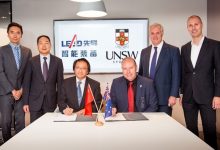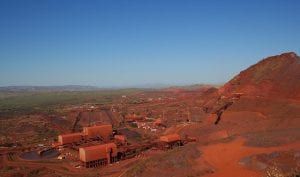Left to right: Research Fellow, Ouyang Zi; Chairman of Wuxi Lead Intelligent Equipment, Mr Yanqing Wang; CTO of Jiangsu Leadmicro Nano-Equipment Technology, Dr Wei-Min LI; Director Knowledge Exchange at UNSW, Warwick Dawson; Dean of Engineering at UNSW, Professor Mark Hoffman; Associate Professor Bram Hoex.
As solar PV continues to smash records for rates of installation and low-cost new power generation around the world, it’s easy to forget that there are still teams of researchers working tirelessly to make the technology even cheaper and more efficient.
Leading the global pack – as it has for decades now – is Australia’s University of New South Wales, which has just quietly announced a rather big deal with a Chinese specialist PV manufacturer to fast-track the mass production of “next generation” PERC solar cells.
PERC – itself a product of the UNSW in the late 80s – stands for Passivated Emitter and Rear Cell, and is basically a more advanced cell architecture that uses additional layer/s on the rear side to improve ‘quantum efficiency’ – i.e. more of the photons which pass through the cell are able to be absorbed.
As UNSW Associate Professor Bram Hoex explains it, the major advantage of the PERC solar cell compared to the incumbent technology is the use of ultrathin films, which reduce electronic losses at the rear of the solar cell.
And it is tipped to be the next big thing in solar PV – and help bring costs of generation as low as 1c/kWh.
According to the most recent International Technology Roadmap for Photovoltaic Results – and you can see this illustrated in the ITRPV chart below – PERC solar cells are expected to hit the mainstream by 2020, and dominate the market by 2022.
The new partnership between the UNSW School of Photovoltaic and Renewable Energy Engineering and Leadmicro, a China-based global manufacturer of advanced solar cell machinery, hopes to help fast-track that shift.
Hoex and his team, backed by grant funding from the federal government’s ARENA, are not just looking at boosting the efficiency of PERC solar, but ensuring they can be mass-produced, without driving up costs.
Currently PERC cells have a potential conversion rate of sunlight into electricity of more than 25 per cent compared to 20 per cent for most traditional solar cell technology.
Hoex and team are looking to develop innovative nanoscale layers which will increase the potential conversion rate of silicon solar cells to over 27 per cent.

“While it may sound like a modest increase in efficiency, this would be an 8 per cent relative increase, which is likely to be achieved without a significant increase in costs, thus further reducing the overall cost of solar electricity,” Hoex said.
The crux of the deal with Leadmicro is the donation of a $1 million Atomic Layer Deposition reactor to UNSW, that will mean that processes created to develop the improved silicon solar cells in a small-scale laboratory setting can be quickly tested and adapted for commercial application.
“The intrinsic goal of this project, which is partly funded by an Australian Renewable Energy Agency (ARENA) grant, is to take our developments quickly and directly into mass production,” Hoex said.
“We’re quite confident that we can do it at a low cost base,” he told RenewEconomy by phone on Thursday.
“We’re not just working on the developing the technology, we’re doing cost analysis as well,” he added. “We have cost models, we have Leadmicro giving us very honest appraisals of costs of manufacturing, and we have a partnership with MERCK, one of the biggest specialty chemical providers in the world, to give us costs on chemistries.
“Solar PV is already the lowest-cost way to make electricity at the moment,” Hoex said. “And we are confident we can – in the medium-term – make it cheaper again by a factor of two.
“We’re part of the consolidated effort by the market to (keep) bringing down costs. …Our work will continue to support the learning rate 40 per cent.
And what about industry predictions that solar PV will soon reach prices of 1c/kWh in some parts of the world?
“Well, the lowest PPA is below 2c/kWh, so it’s definitely going to happen,” Hoex said.
“Definitely there will be spots on the planet that, within the foreseeable future, will be able to produce solar energy for 1c/kWh, so that’s very exciting. And we will continue to push for it.
“There’s a lot of challenges of course, but there’s also a lot of fantastic opportunities. And Australia’s really doing fantastic work in this area.
“In the end, electricity will be a lot cheaper … and we will not be destroying our planet.”
Leadmicro expects to install the ALD reactor at UNSW’s Solar Industrial Research Facility in Kensington by March 2019, with the view to having the next generation PERC solar cells in production in late 2019.








